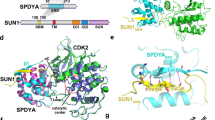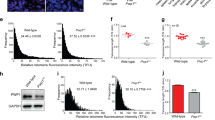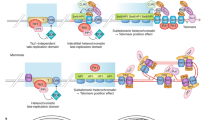Abstract
During meiotic prophase, telomere-mediated chromosomal movement along the nuclear envelope is crucial for homologue pairing and synapsis. However, how telomeres are modified to mediate chromosome movement is largely elusive. Here we show that mammalian meiotic telomeres are fundamentally modified by a meiosis-specific Myb-domain protein, TERB1, that localizes at telomeres in mouse germ cells. TERB1 forms a heterocomplex with the canonical telomeric protein TRF1 and binds telomere repeat DNA. Disruption of Terb1 in mice abolishes meiotic chromosomal movement and impairs homologous pairing and synapsis, causing infertility in both sexes. TERB1 promotes telomere association with the nuclear envelope and deposition of the SUN–KASH complex, which recruits cytoplasmic motor complexes. TERB1 also binds and recruits cohesin to telomeres to develop structural rigidity, strikingly reminiscent of centromeres. Our study suggests that TERB1 acts as a central hub for the assembly of a conserved meiotic telomere complex required for chromosome movements.
This is a preview of subscription content, access via your institution
Access options
Subscribe to this journal
Receive 12 print issues and online access
$209.00 per year
only $17.42 per issue
Buy this article
- Purchase on Springer Link
- Instant access to full article PDF
Prices may be subject to local taxes which are calculated during checkout








Similar content being viewed by others
References
Scherthan, H. A bouquet makes ends meet. Natl Rev. Mol. Cell Biol. 2, 621–627 (2001).
Hiraoka, Y. & Dernburg, A. F. The SUN rises on meiotic chromosome dynamics. Dev. Cell 17, 598–605 (2009).
Scherthan, H. et al. Centromere and telomere movements during early meiotic prophase of mouse and man are associated with the onset of chromosome pairing. J. Cell Biol. 134, 1109–1125 (1996).
Phillips, C. M. & Dernburg, A. F. A family of zinc-finger proteins is required for chromosome-specific pairing and synapsis during meiosis in C. elegans. Dev. Cell 11, 817–829 (2006).
Sato, A. et al. Cytoskeletal forces span the nuclear envelope to coordinate meiotic chromosome pairing and synapsis. Cell 139, 907–919 (2009).
Conrad, M. N. et al. Rapid telomere movement in meiotic prophase is promoted by NDJ1, MPS3, and CSM4 and is modulated by recombination. Cell 133, 1175–1187 (2008).
Koszul, R., Kim, K. P., Prentiss, M., Kleckner, N. & Kameoka, S. Meiotic chromosomes move by linkage to dynamic actin cables with transduction of force through the nuclear envelope. Cell 133, 1188–1201 (2008).
Scherthan, H. et al. Chromosome mobility during meiotic prophase in Saccharomyces cerevisiae. Proc. Natl Acad. Sci. USA 104, 16934–16939 (2007).
Trelles-Sticken, E., Adelfalk, C., Loidl, J. & Scherthan, H. Meiotic telomere clustering requires actin for its formation and cohesin for its resolution. J. Cell Biol. 170, 213–223 (2005).
Ding, X. et al. SUN1 is required for telomere attachment to nuclear envelope and gametogenesis in mice. Dev. Cell 12, 863–872 (2007).
Penkner, A. et al. The nuclear envelope protein Matefin/SUN-1 is required for homologous pairing in C. elegans meiosis. Dev. Cell 12, 873–885 (2007).
Penkner, A. M. et al. Meiotic chromosome homology search involves modifications of the nuclear envelope protein Matefin/SUN-1. Cell 139, 920–933 (2009).
Chikashige, Y. et al. Meiotic proteins bqt1 and bqt2 tether telomeres to form the bouquet arrangement of chromosomes. Cell 125, 59–69 (2006).
Conrad, M. N., Dominguez, A. M. & Dresser, M. E. Ndj1p, a meiotic telomere protein required for normal chromosome synapsis and segregation in yeast. Science 276, 1252–1255 (1997).
Phillips, C. M. et al. HIM-8 binds to the X chromosome pairing center and mediates chromosome-specific meiotic synapsis. Cell 123, 1051–1063 (2005).
Morimoto, A. et al. A conserved KASH domain protein associates with telomeres, SUN1, and dynactin during mammalian meiosis. J. Cell Biol. 198, 165–172 (2012).
Horn, H. F. et al. A mammalian KASH domain protein coupling meiotic chromosomes to the cytoskeleton. J. Cell Biol. 202, 1023–1039 (2013).
Gallardo, T. D. et al. Genomewide discovery and classification of candidate ovarian fertility genes in the mouse. Genetics 177, 179–194 (2007).
Meuwissen, R. L. et al. A coiled-coil related protein specific for synapsed regions of meiotic prophase chromosomes. EMBO J. 11, 5091–5100 (1992).
Crisp, M. et al. Coupling of the nucleus and cytoplasm: role of the LINC complex. J. Cell Biol. 172, 41–53 (2006).
Haque, F. et al. SUN1 interacts with nuclear lamin A and cytoplasmic nesprins to provide a physical connection between the nuclear lamina and the cytoskeleton. Mol. Cell Biol. 26, 3738–3751 (2006).
Lei, K. et al. SUN1 and SUN2 play critical but partially redundant roles in anchoring nuclei in skeletal muscle cells in mice. Proc. Natl Acad. Sci. USA 106, 10207–10212 (2009).
Bianchi, A., Smith, S., Chong, L., Elias, P. & de Lange, T. TRF1 is a dimer and bends telomeric DNA. EMBO J. 16, 1785–1794 (1997).
Huttlin, E. L. et al. A tissue-specific atlas of mouse protein phosphorylation and expression. Cell 143, 1174–1189 (2010).
Liebe, B., Alsheimer, M., Hoog, C., Benavente, R. & Scherthan, H. Telomere attachment, meiotic chromosome condensation, pairing, and bouquet stage duration are modified in spermatocytes lacking axial elements. Mol. Biol. Cell 15, 827–837 (2004).
Adelfalk, C. et al. Cohesin SMC1β protects telomeres in meiocytes. J. Cell Biol. 187, 185–199 (2009).
Herran, Y. et al. The cohesin subunit RAD21L functions in meiotic synapsis and exhibits sexual dimorphism in fertility. EMBO J. 30, 3091–3105 (2011).
Ishiguro, K., Kim, J., Fujiyama-Nakamura, S., Kato, S. & Watanabe, Y. A new meiosis-specific cohesin complex implicated in the cohesin code for homologous pairing. EMBO Rep. 12, 267–275 (2011).
Palm, W. & de Lange, T. How shelterin protects mammalian telomeres. Annu. Rev. Genet. 42, 301–334 (2008).
Jain, D. & Cooper, J. P. Telomeric strategies: means to an end. Annu. Rev. Genet. 44, 243–269 (2010).
Canudas, S. et al. Protein requirements for sister telomere association in human cells. EMBO J. 26, 4867–4878 (2007).
McKerlie, M. & Zhu, X. D. Cyclin B-dependent kinase 1 regulates human TRF1 to modulate the resolution of sister telomeres. Nat. Commun. 2, 371 (2011).
Ogata, K. et al. Solution structure of a specific DNA complex of the Myb DNA-binding domain with cooperative recognition helices. Cell 79, 639–648 (1994).
Bannister, L. A., Reinholdt, L. G., Munroe, R. J. & Schimenti, J. C. Positional cloning and characterization of mouse mei8, a disrupted allele of the meiotic cohesin Rec8. Genesis 40, 184–194 (2004).
Baudat, F., Manova, K., Yuen, J. P., Jasin, M. & Keeney, S. Chromosome synapsis defects and sexually dimorphic meiotic progression in mice lacking Spo11. Mol. Cell 6, 989–998 (2000).
Yuan, L. et al. The murine SCP3 gene is required for synaptonemal complex assembly, chromosome synapsis, and male fertility. Mol. Cell 5, 73–83 (2000).
Kawashima, S. A., Yamagishi, Y., Honda, T., Ishiguro, K. & Watanabe, Y. Phosphorylation of H2A by Bub1 prevents chromosomal instability through localizing shugoshin. Science 327, 172–177 (2010).
Ogawa, T., Arechaga, J. M., Avarbock, M. R. & Brinster, R. L. Transplantation of testis germinal cells into mouse seminiferous tubules. Int. J. Dev. Biol. 41, 111–122 (1997).
Matsuda, T. & Cepko, C. L. Electroporation and RNA interference in the rodent retina in vivo and in vitro. Proc. Natl Acad. Sci. USA 101, 16–22 (2004).
Peters, A. H., Plug, A. W., van Vugt, M. J. & de Boer, P. A drying-down technique for the spreading of mammalian meiocytes from the male and female germline. Chromosome Res. 5, 66–68 (1997).
Acknowledgements
We thank N. Takeda (University of Kumamoto) for assisting in the construction of knockout mice, and Y. Kishi, Y. Ito, M. Yoda and H. Sasaki (University of Tokyo) for technical advice. We also thank all of the members of our laboratory for their valuable support and discussion. This work was supported in part by a JSPS Research Fellowship (H.S.), a Grant-in-Aid for Scientific Research on Innovative and Priority Areas (K.I.), the Global COE Program (Integrative Life Science Based on the Study of Biosignalling Mechanisms), and a Grant-in-Aid for Specially Promoted Research (Y.W.) from MEXT.
Author information
Authors and Affiliations
Contributions
H.S. designed and performed experiments, analysed data and wrote the paper; K-i.I. supervised the experiments; Y.W. supervised the experiment and project and wrote the paper.
Corresponding author
Ethics declarations
Competing interests
The authors declare no competing financial interests.
Integrated supplementary information
Supplementary Figure 1 Sequence alignment of TERB1 homologs in vertebrates.
M. musculus TERB1 was derived from our own sequencing of the cDNA (AB775896). R. norvegicus (XP_226205.5), H. sapiens (NP_001129977.1), P. troglodytes (XP_001159574.2), C. lupus (XP_536822.3), G. gallus(XP_001232198.2) and X. tropicalis (XP_002933719.1) data are from the NCBI protein database.
Supplementary Figure 2 3D tracing of individual telomeres and heterochromatin by live imaging.
Individual telomeres (arrowheads) and heterochromatin (asterisks) were traced for 3 min with 3D information (from sections 5 to 9) to evaluate the relative movements and distances shown in Fig. 2c. Bar, 5 μm.
Supplementary Figure 3 SUN1 but not SUN2 associations with TERB1.
a, Immunoprecipitates from mouse testis-chromatin extracts using TERB1 antibody or control IgG (same IP sample as Figure.6e) were analyzed by the indicated antibodies. SUN1, but not SUN2, associated with TERB1. b, Wild type testis suspension stained for SCP3 (red), SUN2 (green) and DNA (blue). SUN2 signals are detected at the NE in mitotic cells, but is absent in spermatocytes and haploid cells. Asterisks indicate haploid cells. Uncropped images of blots are shown in Supplementary Fig. 6. Bar, 15 μm.
Supplementary Figure 4 GFP-SUN1 and -TERB1 localizations at meiotic telomeres in wild spermatocytes.
The projected and equator images of wild type spermatocytes expressing GFP-SUN1 or -TERB1 stained for SCP3 (red), GFP (green) and TRF1 (blue). Note that overexpressed GFP-SUN1 associates with the NE with telomere accumulations, while GFP-TERB1 exclusively accumulates at telomeres. Bar, 5 μm.
Supplementary Figure 5 Characterization of the TERB1-TRF1 heterocomplex.
a, Purifications of MBP-TERB1, HIS-TRF1 and heterocomplex from E. coli extracts. Note, MBP-TERB1 form a heterocomplex with TRF1 when they are co-expressed in the same E. coli cells. b, Purifications of MBP-TERB1-TRFB domain and HIS-TRF1 from E. coli extracts. While full length MBP-TERB1 is degraded and the stoichiometry with HIS-TRF1 is difficult to be assessed (panel a), MBP-TERB1-TRFB doesn’t show any degradation band and clearly showed 1:1 stoichiometric binding with HIS-TRF1.
Supplementary Figure 6 Entire membranes of cropped immunoblots.
Blue labels on top indicate the antibody used for detection. Dashed red boxes show which region of the immunoblot were cropped for the individual figures.
Supplementary information
Supplementary Information
Supplementary Information (PDF 2188 kb)
Supplementary Table 1
Supplementary Information (XLSX 112 kb)
Live imaging of wild type spermatocytes.
Wild type spermatocytes co-expressing GFP-TRF1 and GFP-SCP3 were cultured in medium supplemented with Hoechst 33324. Images were collected using a DeltaVision microscopy system. Exposures of 0.15 sec (for GFP) and 0.025 sec (for Hoechst 33324) were acquired every 30 sec for 5 min. (AVI 3285 kb)
Live imaging of wild type spermatocytes in the presence of nocodazole.
Wild type spermatocytes co-expressing GFP-TRF1 and GFP-SCP3 were cultured in medium supplemented with Hoechst 33324 and nocodazole. Images were collected using a DeltaVision microscopy system. Exposures of 0.15 sec (for GFP) and 0.025 sec (for Hoechst 33324) were acquired every 30 sec for 5 min. (AVI 3285 kb)
Live imaging of TERB1−/− spermatocytes.
TERB1−/− spermatocytes co-expressing GFP-TRF1 and GFP-SCP3 were cultured in medium supplemented with Hoechst 33324. Images were collected using a DeltaVision microscopy system. Exposures of 0.15 sec (for GFP) and 0.025 sec (for Hoechst 33324) were acquired every 30 sec for 5 min. (AVI 3285 kb)
Live imaging of SUN1−/− spermatocytes.
SUN1−/− spermatocytes co-expressing GFP-TRF1 and GFP-SCP3 were cultured in medium supplemented with Hoechst 33324. Images were collected using a DeltaVision microscopy system. Exposures of 0.15 sec (for GFP) and 0.025 sec (for Hoechst 33324) were acquired every 30 sec for 5 min. (AVI 3285 kb)
Rights and permissions
About this article
Cite this article
Shibuya, H., Ishiguro, Ki. & Watanabe, Y. The TRF1-binding protein TERB1 promotes chromosome movement and telomere rigidity in meiosis. Nat Cell Biol 16, 145–156 (2014). https://doi.org/10.1038/ncb2896
Received:
Accepted:
Published:
Issue Date:
DOI: https://doi.org/10.1038/ncb2896
This article is cited by
-
A report of two homozygous TERB1 protein-truncating variants in two unrelated women with primary infertility
Journal of Assisted Reproduction and Genetics (2024)
-
Distinct dynein complexes defined by DYNLRB1 and DYNLRB2 regulate mitotic and male meiotic spindle bipolarity
Nature Communications (2023)
-
ClpP/ClpX deficiency impairs mitochondrial functions and mTORC1 signaling during spermatogenesis
Communications Biology (2023)
-
Mouse oocytes carrying metacentric Robertsonian chromosomes have fewer crossover sites and higher aneuploidy rates than oocytes carrying acrocentric chromosomes alone
Scientific Reports (2022)
-
Stage-resolved Hi-C analyses reveal meiotic chromosome organizational features influencing homolog alignment
Nature Communications (2021)



